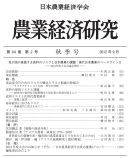All issues

Volume 77 (2005)
- Issue 4 Pages 177-
- Issue 3 Pages 93-
- Issue 2 Pages 57-
- Issue 1 Pages 1-
Volume 77, Issue 4
Displaying 1-2 of 2 articles from this issue
- |<
- <
- 1
- >
- >|
full-paper
-
HU Bai2006Volume 77Issue 4 Pages 177-187
Published: March 25, 2006
Released on J-STAGE: October 31, 2014
JOURNAL FREE ACCESSBased on an examination of the method and results of project evaluation conducted by the Ministry of Agriculture, Forestry and Fisheries (MAFF), this paper develops a framework, characterized by combining time-serial and cross-sectional analysis, to identify the performance of the public investment for sustainable agriculture. The empirical analysis for the 1999-2002 period projects implemented by prefectures shows an expected performance in identifying the net impact of these projects on promoting the development of sustainable agriculture, and the possibility in improving MAFF project evaluation. The empirical results also suggest that these projects have substantially promoted the growth of eco-farmers with diminishing project performance, while the same effects are not found in certified organic farmers.View full abstractDownload PDF (454K) -
Masahide WATANABE, Kota ASANO2006Volume 77Issue 4 Pages 188-195
Published: March 25, 2006
Released on J-STAGE: October 31, 2014
JOURNAL FREE ACCESSThis paper applies a contract theory to examine whether the voluntary approach, which has recently attracted attention as one of the environmental control policies, is efficient for the exertion of the multifunctionality of agriculture. The conclusions obtained through the analysis are the following four points.
1. In voluntary approaches, when it is socially costly to collect the subsidy, first best solutions cannot be achieved.
2. In voluntary approaches, optimal menus obtained when only participation constraints are imposed cannot be implemented, because optimal menus for each type cannot be compelled. Therefore, even if farmers' types can be observed, incentive compatible constraints need to be imposed.
3. When the probability distribution of the net marginal cost holds to the monotone hazard rate condition, as the net marginal cost of farmers or the social cost to collect the subsidy decreases, optimal levels in voluntary agreements increase. Furthermore, when the social cost to collect the subsidy is zero, first best solutions can be achieved.
4. When the net marginal costs or the social cost to collect the subsidy is so high, non-participation is optimal.View full abstractDownload PDF (1180K)
- |<
- <
- 1
- >
- >|